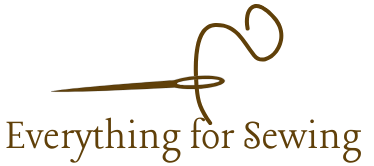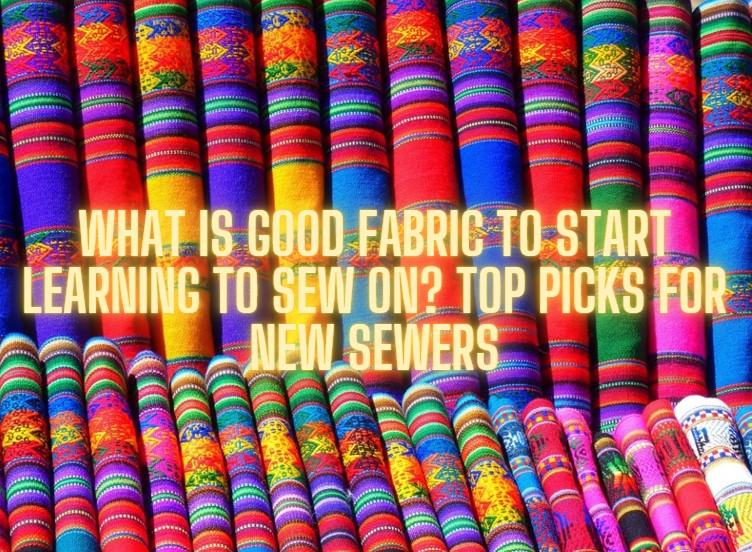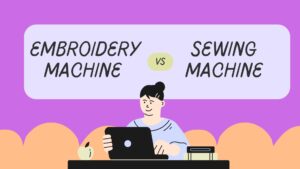Contents
- 1 Table of Contents
- 2 Characteristics of Beginner-Friendly Fabrics
- 3 In-Depth Guide to the Best Fabrics for Beginners
- 4 Tips for Sewing with These Fabrics
- 5 Additional Beginner Fabrics to Explore
- 6 Sewing Tools to Make Your Life Easier
- 7 Common Beginner Mistakes to Avoid
- 8 Final Thoughts
- 9 FAQs: What Is Good Fabric to Start Learning to Sew On?
- 9.1 1. What is good fabric to start learning to sew on if I’m a complete beginner?
- 9.2 2. Is muslin a good fabric to start learning to sew on?
- 9.3 3. Why is cotton considered good fabric to start learning to sew on?
- 9.4 4. Can I use stretchy fabric as a beginner?
- 9.5 5. What is good fabric to start learning to sew on if I want to make clothes?
- 9.6 6. Is flannel a good fabric to start learning to sew on?
- 9.7 7. Are there any fabrics I should avoid as a beginner?
- 9.8 8. What sewing tools work best with beginner fabrics?
- 9.9 9. Can I use felt for beginner sewing projects?
- 9.10 10. Where can I buy good fabric to start learning to sew on?
- 9.11 11. How can I ensure the fabric I choose is good for learning to sew on?
- 9.12 12. What projects are best for beginners learning to sew?
Table of Contents
Starting your sewing journey can feel overwhelming, especially when faced with the variety of fabrics available. A common question for beginners is, “What is good fabric to start learning to sew on?” The right fabric can simplify the process, allowing you to focus on mastering techniques like cutting, stitching, and ironing. In this detailed guide, we’ll expand on the best fabrics to choose and offer additional tips for making your sewing experience enjoyable.
Characteristics of Beginner-Friendly Fabrics
When deciding what is good fabric to start learning to sew on, look for these qualities:
- Stability: Fabrics that don’t stretch or shift under the needle are easier to manage.
- Ease of Cutting: Choose materials that hold their shape well, making it simple to cut accurately.
- Minimal Fraying: Fabrics that don’t unravel too much save you the frustration of finishing every edge.
- Affordability: Practicing on budget-friendly fabrics allows room for mistakes without financial stress.
Let’s dive deeper into each of the beginner-friendly fabrics and their specific advantages.
In-Depth Guide to the Best Fabrics for Beginners
1. Cotton: The Gold Standard for Beginners

Cotton tops the list for anyone wondering what is good fabric to start learning to sew on.
- Widely Available: You’ll find cotton in a variety of prints, colors, and weights at any fabric store.
- Perfect for Practice: Its forgiving nature makes it easy to redo stitches or seams.
- Project Ideas: Start with simple items like napkins, aprons, or even basic tote bags.
When selecting cotton, look for quilting cotton or broadcloth—they are less slippery and easier to handle than finer cottons.
2. Muslin: The Ultimate Practice Fabric

Muslin is a favorite for testing patterns or practicing stitches.
- Low Cost: Ideal for beginners who might make mistakes and need extra fabric.
- Plain Weave: Its simple texture makes it easy to spot mistakes in stitches.
- Versatile Uses: Use muslin for pattern mock-ups, known as toiles, to refine designs before cutting expensive fabric.
3. Felt: Great for Beginners and Crafters

For those focused on small-scale projects, felt is a beginner’s best friend.
- Doesn’t Fray: No need to worry about hemming or finishing edges.
- Thick and Manageable: Its sturdy texture stays put as you sew.
- Beginner Projects: Try making coasters, soft toys, or decorative items like garlands.
4. Linen Blends: A Natural Choice

If you want to experiment with garments, linen blends are an excellent starting point.
- Smoother Than Pure Linen: Blends often incorporate cotton, making them easier to sew.
- Minimal Wrinkling: Easier to manage compared to 100% linen.
- Ideal Projects: Shift dresses, lightweight tops, or drawstring bags.
5. Flannel: Cozy and Forgiving

Flannel is perfect if you want to try sewing cozy items while keeping things simple.
- Soft Yet Manageable: Its slight thickness adds stability while sewing.
- Warm and Functional: Great for blankets, pajamas, and scarves.
- Beginner-Friendly: Less slippery than fabrics like fleece or jersey.
Tips for Sewing with These Fabrics
To make the most of your beginner-friendly fabrics, keep these tips in mind:
- Pre-Wash Your Fabric: Some fabrics, like cotton and flannel, shrink when washed. Pre-wash to avoid surprises after completing your project.
- Use the Right Needles: A universal needle is suitable for most beginner fabrics, but ensure it’s sharp and appropriate for your material’s thickness.
- Practice on Scraps: Before starting a project, test your machine’s tension and stitch settings on fabric scraps.
- Iron Your Fabric: Smooth fabrics are easier to cut and sew accurately.
Additional Beginner Fabrics to Explore
If you’re ready to experiment beyond the basics, here are a few other fabrics to try:
Denim (Lightweight)
Denim can be a good next step once you’ve mastered cotton. Opt for lighter-weight denim, which is easier to handle than thicker versions.
- Great for Bags and Aprons: Its durability makes it perfect for functional projects.
- Practice Reinforced Stitches: Ideal for learning topstitching and seam finishing.
Canvas
Canvas is a heavier, stable fabric that’s excellent for tote bags and home decor.
- Sturdy Texture: It stays in place while sewing and doesn’t fray excessively.
- Project Ideas: Try sewing storage bins, aprons, or outdoor cushions.
Sewing Tools to Make Your Life Easier
Choosing what is good fabric to start learning to sew on is essential, but having the right tools is equally important:
- Rotary Cutter and Cutting Mat: Makes cutting fabric faster and more precise.
- Seam Ripper: A must-have for undoing mistakes.
- Fabric Clips or Pins: Secure fabric layers together for smoother stitching.
- Pressing Tools: Use an iron or seam roller to press seams flat for a polished finish.
Common Beginner Mistakes to Avoid
- Skipping Pre-Washing: Some fabrics shrink or lose dye during the first wash.
- Using the Wrong Needle: Always match the needle size to the fabric weight.
- Not Adjusting Tension: Check that your sewing machine’s tension is set correctly for the fabric.
Final Thoughts
To answer the question, “What is good fabric to start learning to sew on?”, look for fabrics that offer stability, affordability, and ease of handling. Cotton, muslin, felt, linen blends, and flannel are your best bets for gaining confidence as a new sewer. Once you’ve mastered these materials, you can gradually explore more challenging fabrics to elevate your skills.
Sewing is a rewarding craft, and with the right fabric and tools, you’ll enjoy the process from the very beginning. Now, it’s time to pick your favorite fabric, set up your sewing machine, and start creating!
FAQs: What Is Good Fabric to Start Learning to Sew On?
1. What is good fabric to start learning to sew on if I’m a complete beginner?
The best fabric for complete beginners is cotton. It is stable, easy to cut, doesn’t slip while sewing, and holds its shape well. Quilting cotton is particularly recommended for practicing stitches and creating simple projects like tote bags or pillowcases.
2. Is muslin a good fabric to start learning to sew on?
Yes, muslin is an excellent choice for beginners. Its affordability and ease of use make it ideal for practicing sewing techniques or testing patterns. Because muslin doesn’t stretch or fray excessively, it helps beginners focus on perfecting their skills.
3. Why is cotton considered good fabric to start learning to sew on?
Cotton is considered one of the best fabrics for learning to sew because it’s:
- Sturdy and easy to handle.
- Widely available in various patterns and colors.
- Affordable, allowing beginners to experiment without worrying about ruining expensive fabric.
4. Can I use stretchy fabric as a beginner?
Stretchy fabrics like jersey or spandex are not recommended for beginners. These materials can be difficult to sew evenly and often require advanced techniques. Instead, focus on stable options like cotton or muslin when figuring out what is good fabric to start learning to sew on.
5. What is good fabric to start learning to sew on if I want to make clothes?
If your goal is to sew simple garments, linen blends or lightweight cotton are excellent choices. They are easy to cut, sew, and press, making them ideal for shirts, dresses, or skirts. Avoid slippery or sheer fabrics until you’re more experienced.
6. Is flannel a good fabric to start learning to sew on?
Flannel is a beginner-friendly fabric, especially for cozy projects like pajamas, scarves, or blankets. Its soft texture and slightly heavier weight make it easy to handle and sew accurately.
7. Are there any fabrics I should avoid as a beginner?
Yes, beginners should avoid slippery, stretchy, or sheer fabrics like satin, silk, spandex, and chiffon. These materials are challenging to sew and can lead to frustration. Stick to stable fabrics like cotton or felt when deciding what is good fabric to start learning to sew on.
8. What sewing tools work best with beginner fabrics?
When working with beginner-friendly fabrics like cotton, muslin, or felt, you’ll need:
- A universal sewing machine needle.
- Sharp scissors or a rotary cutter for accurate cuts.
- Fabric clips or pins to keep your fabric layers in place.
9. Can I use felt for beginner sewing projects?
Absolutely! Felt is one of the best answers to what is good fabric to start learning to sew on for crafts and small projects. It doesn’t fray, is thick and stable, and is perfect for making coasters, soft toys, or decorations.
10. Where can I buy good fabric to start learning to sew on?
You can purchase beginner-friendly fabrics like cotton, muslin, or felt at fabric stores, craft shops, or online retailers. Look for beginner fabric bundles or quilting cotton packs for a budget-friendly option.
11. How can I ensure the fabric I choose is good for learning to sew on?
When selecting fabric, check its stability, weight, and texture. Stick to natural fibers like cotton or linen blends and avoid fabrics that stretch or slip. If you’re ever unsure, ask a store associate for recommendations on what is good fabric to start learning to sew on.
12. What projects are best for beginners learning to sew?
Simple projects like tote bags, pillowcases, aprons, and napkins are perfect for beginners. These projects work well with beginner-friendly fabrics and help you practice straight seams, hemming, and stitching.
You may also be interested in this article Hand Sewing Kits with Thread Guide: A Comprehensive Buying Guide




